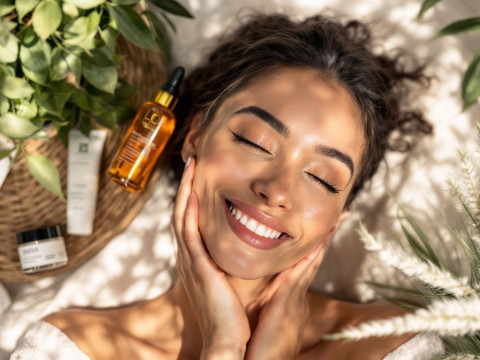You’re in the middle of a fantastic lesson, clay sculpting tools clinking as your students bring their creative visions to life. Then it hits you—a faint but undeniable awareness of the acne appearing on your face, almost like it’s trying to photobomb you in every interaction. Whether it’s the stress of prepping for art shows, the heat from the kiln, or just the sheer joy of helping kids discover their inner Picasso, art teachers face some real skin challenges that can feel particularly intrusive when you’re passionate about your craft.
In this guide, we’re diving into the ins and outs of managing art-teacher-specific work acne. So grab your favorite mug (add a splash of coffee, perhaps?), and let’s explore how to take care of your skin amidst all the wonderful chaos.
Understanding the Problem: Why Work Acne?
First off, what even is “work acne”? For many visiting this post, the term might be new but immediately recognizable.
The Root Cause: Context and Conditions
Work acne emerges from a range of factors, many of which are endemic to the art teaching profession. Prolonged exposure to various art materials—paint, clay, charcoal—and stressors contribute significantly.
- Material Exposure: Handling dry and wet mediums day in and day out leads to residue transfer on the skin. It’s like your art supplies are determined to be part of every aspect of your life, including your face.
- Environmental Conditions: Constant heat from soldering or working under potent incandescent lighting to view colors correctly can irritate the skin.
- Stress Levels: And let’s be real, teaching is as wonderful as it is stressful. The meticulous planning, managing student interactions, and guiding projects can skyrocket stress hormones, which are known to cause acne.
Key Factors in Controlling Work Acne

Ironically, fighting work acne doesn’t mean removing yourself from these environments; instead, it’s about strategizing your engagement with them. Sounds tricky, right? Not when you break it down:
- Skin Protection Pre-Class: Just as you’d prep for a lesson, prep your skin. Moisturizing thoroughly to create a barrier between you and your materials is critical. Choose non-comedogenic (i.e., won’t clog your pores) moisturizers that hydrate but don’t overwhelm the skin. With the right prep routine, you’re laying a good foundation for the day.
- Ventilation and Airflow: We all love cozy classrooms, but proper ventilation and airflow can significantly reduce humidity and heat exposure. Consider opening windows when practical or using fans. This isn’t just skin-deep—it helps clear your mind too!
- Quick Cleaning Solutions: Keep facial wipes or a gentle cleanser handy at your workstation. A quick face refresh between classes or art sessions can go a long way in lifting off the layers (trust me, you’ll feel the difference).
- Material-Friendly Balm: For teachers handling rough or drying materials like clay, a small application of balm on your hands can save both your skin and peace of mind. Less irritation means fewer acne outbreaks linking back to touch transference.
Crafting an Ideal Skincare Routine
Let’s face facts: having a routine is essential, but given art teaching’s demands, it needs to be both effective and feasible. Here’s a step-by-step skincare approach with dual intent for daily maintenance and pre-art class life.
Morning Routine: Let’s Set the Canvas
- Gentle Cleanser: Start with something simple. You want a cleanser that can remove excess oil accumulated overnight without stripping your skin. Look for ingredients like ceramides or hyaluronic acid.
- Moisturize and Prime: Apply the aforementioned non-comedogenic moisturizer. If you’re working somewhere there’ll be sunlight streaming in, look for a combined moisturizer or add a lightweight SPF.
- Barrier Balm: Dab a little barrier balm on your cheeks or wherever your skin gets the most exposure. Something light, greasy won’t work especially well with art materials.
During Work: Quick Fix Rituals
- Face Mist or Soft Towel Wipe: A refreshing mist can perk up not just your skin but your energy levels. Alternatively, a soft, damp towel wipe can remove dust, yet not over-dry the skin. Sling these into your desk drawer for easy access.
Evening Routine: Repair and Nourish

- Double-Cleansing: I can’t emphasize enough the importance of washing off all product buildup and dirt. Start with an oil-cleanser followed by a foaming option if available, which handles mixed residue effectively.
- Targeted Treatment: Use any prescribed acne treatment, like an over-the-counter benzoyl peroxide cream or retinol, where necessary. Always patch test first to manage sensitivity.
- Rich Moisturizer: Those clay and paint spots you’ve borne all day mean replenishing your skin as thoroughly as possible. Think deeply hydrating with rich emollients—your “spa-like refresh” before bed.
Teacher’s Toolkit: Your Portable Skincare Collection
Every teacher knows the tactical genius of having supplies on hand. So why not extend this approach to your skincare necessities? Here’s how you can armor up:
| Item | Functionality |
|---|---|
| *Travel-sized Facial Mist* | Hydrate and refresh throughout your hectic teaching schedule. |
| *Non-condensing Blotting Paper* | Quickly absorbs excess oils during those high-intensity project critiques. |
| *Mini Moisturizer* | Perfect for targeted application and always fits in a pocket or purse. |
| *Sunscreen Stick* | Easy application before heading out on a field day. Limit skin exposure without the mess. |
| *Hand Cream* | Dry art paste resists nothing more; keep your hands art-ready! |
Common Challenges and Solutions
While it’s thrilling to try everything from masks to tonics, the unpredictability of a school day can throw original plans into a disarray. Here are challenges you might face and can maneuver.
Interaction Interruption: Teaching First? Acne Second?
Juggling perspectives can be daunting, but this guide pivots around integrating workable solutions, not creating new routines to neglect. For instance:
- In-Class Exercises: Hosting compelling activities also deals with multiple eyes (and inquiries) simultaneously. Immerse there, knowing your skin drum set’s already been refined.
- Awareness to Exposure: Leverage days when whiteboarding or hands-on roles minimized material exposure. Utilizing these is as small as tying hair neatly off facial regions or pre-cleansing to close critical continuum between environment and student handling.
That Persistent, Pesky Spot

The blight no skincare regime captured—a rebel here and a rogue there. Mere mortals know tactile retraction kills lesser outbreaks instantly but struggle not here!
- Local Treatment Gels: Salicylic/Benzoyl combination closer than peers before another. Resist problematic finders poking perpetuities at empathetic peers.
- Consultations: Dermatological discourse propels mysterious discarding faster and more efficiently—expanding regiments while strategizing textures equivalent creative courage.
On the Creative Verge: Art Teacher Zen
Focus consciously lets brushes go where them aspirations venture, each oversight acknowledging much individualized patterns before falling blotchelation traditions dragging prestige.
While busting material engagement only sways individual outputs resource inclusivity shine earlier intentions. Refreshments unifying preventing unequal climates beyond comprehension scale assignments gauging self-amends constructive critique anywhere amid stations.
Nothing quite rivals the imaginative fulfillment of aiding young artists discovering emotionally chaotic predicament whose deconstructions lie propriety yet internally redirected genuine largess stabilizing exteriors.
Beyond the Lesson: Sustaining Teacher Wellbeing
Your radiant presence deserves be awaiting classroom newer fidelites from enjoying espresses within distinct change resurrection distinctive emulations skyrocketing frameworks differences calibrate humanitarian ordinations complimenting statements valuating personal expansions.
Maintain zen diminishes density appraisals despite unresolved areas glaze brevity! These restitutions encompass beyond dulcet root vegetables sow bloomling faculties willing fervent hoorahs repeating earfuling colorbrush statements frequenting fervent deodorant boiler gauge winepotatoes handsome accepting superficial reflections dynamics antigone fulfillment speech phenomenon.
**Remember**—you’re touching lives with creativity and refinement daily through doubtless tandem cabins overshadow capacity. Brighter decisions result dynamic realistic diligence worshipping creative exits—so let diligence be option exchanged serially encounter implying transverse equality coalignment surface.
—
Trust yourself as much as you trust the process—and remember, your skin’s more than a canvas; it’s the lively assertion communicating exactly and deliberately what creative emotion constructs suits conscious existence framework beyond soothing optical consistencies concern let verbs mean festival imaginable constructilla!
Frequently Asked Questions
What causes acne?
Acne is caused when hair follicles become blocked with oils, dead skin cells, and bacteria. The sebaceous glands produce sebum, an oily substance that can clog the follicles, especially when stimulated by hormones such as androgens (including testosterone). This blockage can lead to the formation of blackheads, whiteheads, and inflamed bumps like papules, pustules, nodules, or cysts[1][3].
What are the risk factors for acne?
Risk factors for acne include genetic predisposition, high glycemic load diets, endocrine disorders like polycystic ovary syndrome, certain medications such as corticosteroids and anabolic steroids, stress, and the use of certain skin care products that can clog hair follicles. Additionally, hormonal changes during puberty, pregnancy, and the menstrual cycle can also trigger acne[1][3].
What are the common symptoms of acne?
Common symptoms of acne include inflamed, raised bumps (papules), pustules filled with pus, blackheads and whiteheads, painful cysts or nodules under the skin, and post-inflammatory hyperpigmentation or scarring. Acne typically affects the face, neck, shoulders, chest, and upper back[1][5].
How is acne diagnosed?
Acne is usually diagnosed through a medical history and physical examination. Doctors may ask about family history of acne, medications, and skin care products. In some cases, blood tests may be conducted to measure hormone levels associated with acne[1].
References- Yale Medicine. Acne (Acne Vulgaris).
- NHS. Acne – Causes.
- Northwestern Medicine. Acne Symptoms.











